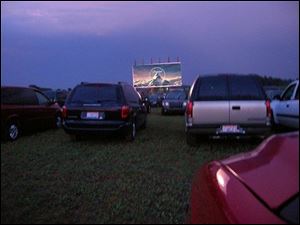
Drive-ins toss the celluloid for digital upgrade
Region’s open-air theaters to offer enhanced experience
3/30/2013
Owners of the Field of Dreams Drive-In in Liberty Center, Ohio, took out loans to invest in digital projection equipment.
Going to a drive-in theater is all about the outdoor pop-cultural experience, but this spring, the region’s open-air movie corrals will enhance that experience through a technological upgrade.
Over the last few years, the film industry has urged theater owners to retire their old 35-mm film projectors in favor of digital projection equipment.
But this year, the request became a dire threat: Either make the switch or risk going out of business because from now on, all movies will be digital files.
In other words, no more film.
“I said from the start that I believed they were going to do this. There were too many people on board wanting to do it,” said Jim Walter, owner of the Toledo-based Great Eastern Theaters chain, whose properties include the Sundance Kid Drive-In in Oregon as well as the Springmill Drive-In in Mansfield, Ohio.
“The equipment industry was driving this because they had the most to gain from it,” Mr. Walter said.
So after decades of loading celluloid reel-to-reel classics onto his projectors, Mr. Walter made the switch this year and his drive-ins will open next weekend and provide carloads of customers with the digital experience they now get in his indoor theaters in Fremont and Maumee.
Likewise, Rod and Donna Saunders of Liberty Center got loans from two northwest Ohio banks to invest in digital projection systems for their Tiffin and Liberty Center drive-ins.
New digital projection systems, which dominate the theater industry, are not cheap.
A report last year about a Kansas City drive-in that converted to a digital projection system listed the cost at $86,000 total for a projector, computer server, hard drive, sound decoder, automation system, lens system, and other infrastructure changes.
Mr. Walter said buying just a projector and computer equipment are insufficient. Owners also must remodel the projection booth in which they reside to maintain a stable temperature. The cost: about $2,500.
“We actually bought our [digital system] last May, but it’s been sitting in storage until we were ready,” he said. “We’ve been working at our leisure to get it installed and we learned we had to build a [projection] booth inside a booth to isolate the system from dust.
“You also have to keep it in a 20-degree temperature range, so there’s the heating and air conditioning that also has to be maintained,” Mr. Walter said.
For the Saunderses, their new digital system at their Field of Dreams-Tiffin Drive-In debuted this weekend. Their Field of Dreams Drive-In in Liberty Center, featuring its digital system, opens next Friday.
“Our options were to make the significant investment in the digital projection equipment or close the business when 35 mm is no longer available,” Mr. Saunders said. “Industry signs suggest that date would be sometime in 2013,” he said.
While the investment is sizable, Mrs. Saunders said that she believes customers will really enjoy the upgraded picture and sound quality.
Fortunately for many drive-in owners, Cinedigm, a digital projection company, and the National Association of Theatre Owners introduced a program in February to help offset the high cost of digital conversion. The program helps offset the cost through “virtual print fee” — a payment for each time a drive-in shows a digital movie. The movie studios provide the virtual print fee, which is funded by the nearly $1,300 that studios save on making and shipping a 35-mm print.
Instead of cans of 35-mm film, Great Eastern recently received a computer disk with a film — G.I. Joe: Retaliation — and a computer code key to play it on his system. Eventually, the films will be transmitted by satellite, Mr. Walter said.
“The good news for drive-ins is the high expectation we had for a better picture and more crispness with digital, that’s all true for drive-ins,” he said. “We have a picture on the screen that’s better than we’ve ever had before. It’s bright, clear, and even after you’ve shown it for a while, there’s no scratches.
“It’s as good into the fourth week as it is on the first week,” Mr. Walter said.
Contact Jon Chavez at: jchavez@theblade.com or 419-724-6128.